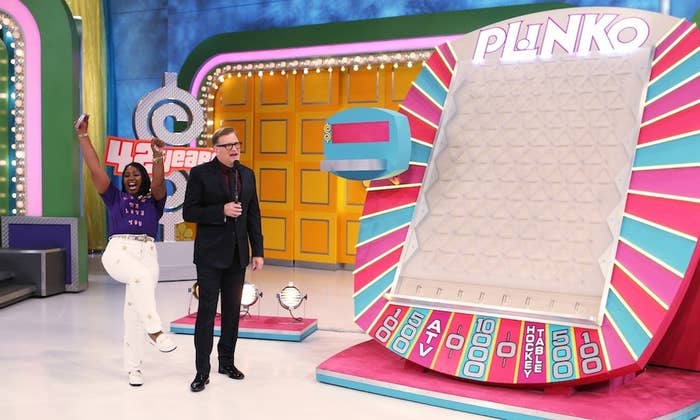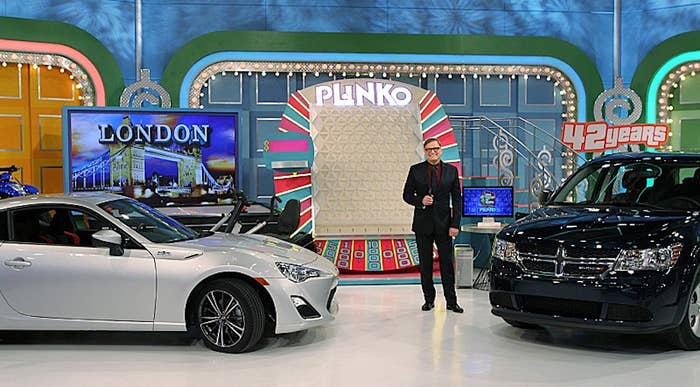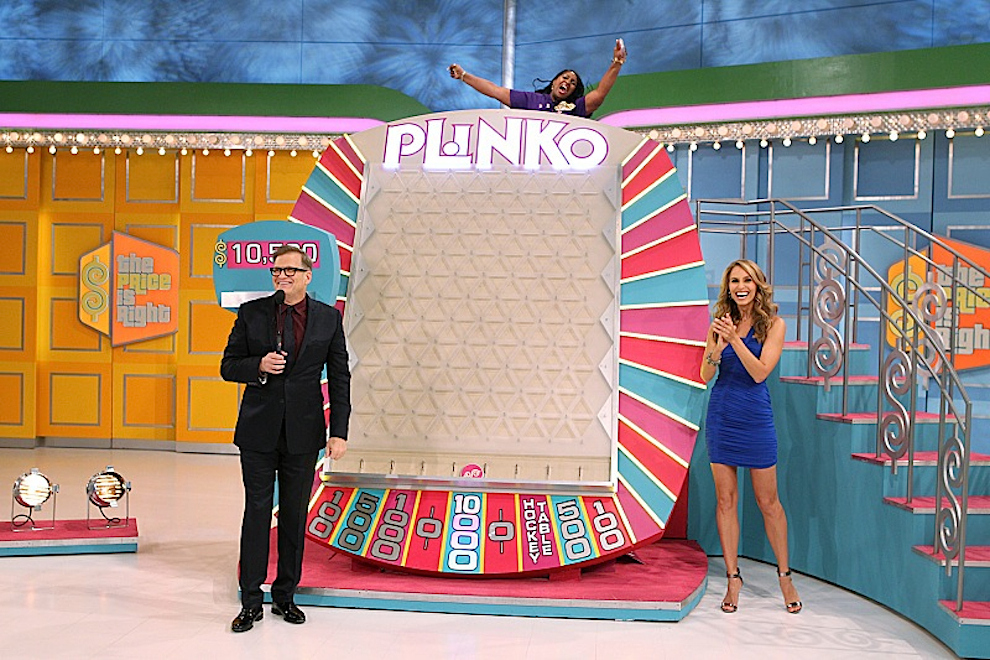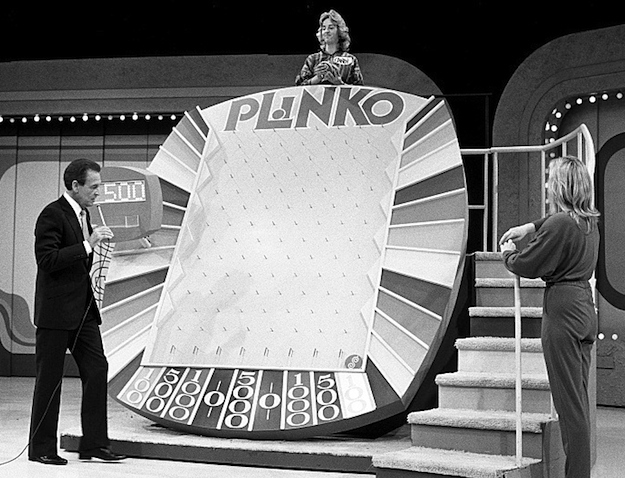
LOS ANGELES — Friday, we witnessed television history. For the first time ever in The Price is Right's 42 year history, the daytime game show was dominated by a single game: Plinko.
If you know The Price is Right — and how could you not, are you an alien or something? — you know Plinko. It is a pretty simple game: Contestants must correctly guess a series of prizes valued under $100 to win Plinko chips that they then drop down a giant slanted peg board into a series of cash-value slots at the bottom, usually valued between $0 and $10,000. It is also by far the most popular game that has ever been featured on The Price is Right. "It's one of my favorites," host Drew Carey told BuzzFeed on set of the all-Plinko episode. "I honestly think a lot of it has to do with anticipation — just the amount of time it takes the chip to get down to a prize, and how it bounces around… and the randomness of it."
This year marks Plinko's 30th anniversary, and to celebrate, Carey and The Price is Right executive producer Mike Richards conspired to create the first all-Plinko episode, which is usually structured with six separate pricing games. But at the June 26, 2013 taping of a special The Price is Right episode — which aired earlier today — contestants would play only Plinko, six times in a row.
And, as Richards explained before the show, the audience would have no idea what they were walking into. "They will know it's the 30th anniversary, but they won't know until about the third time it comes out that it's all Plinko, all the time," said Richards. "Which will be fun!"
It was fun. But during BuzzFeed's exclusive peek behind the scenes, it turns out that when a 42-year-old television institution that runs like a Swiss watch tries to do something it's never done before, things can also get a little frustrating.

Breaking The Mold
Before every episode The Price is Right tapes at CBS Television City in Los Angeles, every beat of the show has to be rehearsed with the crew, and the Plinko episode was no different. Production assistants were racing around the stage setting up various elements of the show as one of the models, casually clad in jeans and a leather jacket, walked through the beats of one of the "one-bid" prizes with the stage manager. (They're the prizes contestants bid on to determine who gets to play the next game, or in this case, who got to play Plinko next.) At one point, the model was spun around on a small circular platform, to reveal her singing into a karaoke machine. "You got two turntables and a microphone!" said the stage manager. "See what I did there?" The model smiled and nodded slowly, before heading over to her next prize package, an elliptical trainer and an enormous Mac Pro. (The implication being if you work on a computer that high-powered, the only exercise you're likely to get is at home.)
Overseeing it all was Mike Richards, sitting at table on the showcase showdown stage with his other producers. Tanned, handsome, and 37, Richards projected the unflappable air of a man who knows he's one of the luckiest producers in Hollywood. But he looked a little uneasy. Usually, the elements of The Price is Right are so second nature to the production staff that, well, the stage manager put it to me this way: "Game shows after a while are like slicing sausage." But to keep the all-Plinko episode from feeling too monotonous, Richards and his team had included five variations of Plinko prizes — cars, trips, all-terrain vehicles, that elliptical trainer, etc. All those prizes had to be introduced and presented, of course, adding another layer of complicating novelty to an already unique show. Things were running a little behind, and they hadn't even brought in the audience yet.

High Above The World Below
(Full disclosure: I was asked during rehearsals if I wanted to be a stand-in contestant for one of the rounds of the game during rehearsal, and since that meant I got to play Plinko, of course, I said yes. It was as exciting as you might imagine just for the experience of getting to see what it looks like standing on the top of the Plinko board, which you can see above. But my performance was less than stellar, especially in comparison to my BuzzFeed colleague Leonora Epstein, who also got to be a stand-in contestant. You can read her lovely account of the experience here.)
Once the rehearsal was finished and the audience began loading in, Richards admitted he was nervous about the show running over. "I am very concerned about the run time," he told BuzzFeed. "Plinko is a longer game. And then, because we're adding in prizes in addition to the small prices that they have to price, that extends the run time even longer. So even if we just played basic Plinko at its normal time, we would be long. In this way, we will be extraordinarily long."

Deep Breaths!
The thing about being an audience member on The Price is Right is that you are basically cheering and clapping nonstop for an hour (at least), and you don't really realize it until it's all over. "I sat in the audience before I worked here," Richards said, "and I remember going home and going, 'Why are my hands sore?' It was from clapping. I was exhausted and my voice was hoarse. I was like, That's the most insane thing I've ever been through in my life."
That unbridled enthusiasm is palpable inside the studio, in no small part because, unlike so many other game shows, each audience member is also a potential contestant, almost all of whom have made it a Bucket List goal to try to be a contestant on The Price is Right. So, even though the first contestant to play Plinko only won two chips (out of a possible five), and only scored $500 (he hit $0 with one of his chips), when he stepped off the stage, he was still vibrating with excitement. "OK!" he said with a deep breath. "I'm calm now!" (To be clear: This man, at this moment, did not appear to be anywhere close to calm.)

"It Fires Us Up When They Win"
It is an illusion-shattering experience to stand backstage on a game show you have watched since childhood. You realize that, say, the big day-glo colored doors that seem to effortlessly glide open to reveal the latest prizes are, in fact, pulled open by burly stagehands, and, as they open, they sound like someone knocking over a stack of empty plastic storage tubs.
But you also get to witness the illuminating spectacle of a junior producer swiftly swapping out the previous round of pricing games with new prizes — and new prices — and then double and triple checking that each prize matches each price, both fake and real. It's silly, but before that moment, I had never considered that there would be people whose job it is to ensure proper prize-price continuity on The Price is Right. After the show, Richards explained that usually, these producers go through this painstaking process for each game well before the show tapes. But since there is a finite number of Plinko chips on hand — the production only has 10 — and even fewer specialized Plinko displays for the low-value prizes, the production had to reset the game after each round and go through all the price-checks on the fly. Understandably in these rarefied circumstances, mistakes can be made. In the next round, the model showcasing the pricing-game prize messed up revealing the correct price, and the show had to reshoot it.
Even worse: The contestant didn't win any money at all. It wasn't until Round 3 that a contestant was a big winner, claiming all five Plinko chips, and hitting both the slot for a new ATV, and — to the visible excitement of many of the crew and producers backstage — the $10,000 slot.
"I think people would be surprised to know how much the staff still gets excited on a big win," Richards said before the show. "There's always that moment where we're all super excited, and then it's like, 'Oh wait, yeah, we're not watching. We're doing the show.' I think people might think after a while it would get tiresome, like, Ugh. Back to giving things away again! And it's not. You know that this is a huge day for people, and I think that fires us up when they get close and they win." He paused. "And disappoints us when they lose."

"I've Never Seen That Many Zeroes"
After the first Showcase Showdown, the breaks between games grew longer and longer, slowly sapping away the audience's vigor. At first, Carey valiantly kept the crowd buoyant with some talk-to-the-audience banter honed by years on the stand-up comedy circuit. "That's my favorite part of the show, some days — just talking to the crowd," Carey said. "Everyone has a story to tell, and non-celebrities are the best people to talk to because they have the best stories to tell."
But usually these breaks last roughly as long as a regular commercial break would — not 10 to 15 minutes each. By the time the fourth round was ready to go, the audience's energy was so noticeably lagging, one might almost suspect the Plinko gods were displeased. Because the next three rounds featured seven separate $0 Plinko drops, a maddeningly unsatisfying result. By the last drop of the show, the audience began chanting, "$10,000! $10,000!" (Instead, the contestant landed on $100.)
"I hated all the zeroes," Carey said after the show. "It was killing us. We were just so clearly frustrated that more people didn't win more money. We set up everything to be so easy, like, really easily guessing things to get chips. So I thought it went well. I'm glad we did it. But I was like, Man, there should have been a lot more winning than there was. It just bums me out when that happens."

When asked about all the zeroes, Richards strikes a more philosophical tone. "That was unusual," he allowed. "I've never seen that many zeroes. I've seen 100s and 500s and 1,000s, but that was particularly rare," he chuckled. "There was a lot of drops. And someone won $10,000, which was good. I would've loved for [someone] to have won a car, because no one's won a car on Plinko. It just means we will have to do it again in some way."
On the flip-side, the show wasn't nearly as overlong as Richards had feared. "We were only, like, a minute and change long in the end, because we picked up a little time in the showcases," he said. Still, don't expect to see another Price is Right game take over the show again. "I think Plinko is so iconic and special in its own way. I knew that if we did this, this would be the only time that we would ever do it," Richards said. "We pride ourselves on being creative enough to keep coming up with firsts, even though we've been doing this for 42 years. So we'll never do that again — not because I don't think it went well or anything, just because we have to beat ourself creatively in what we'll do next time to celebrate something else."
Carey, at least, thinks there could be good money, so to speak, in an all-Plinko game show. "I don't think it'd be a regular show, but a web show or something like that that's on a low budget," he said, chuckling. "Nothing but Plinko. It couldn't be that tough to do!"

